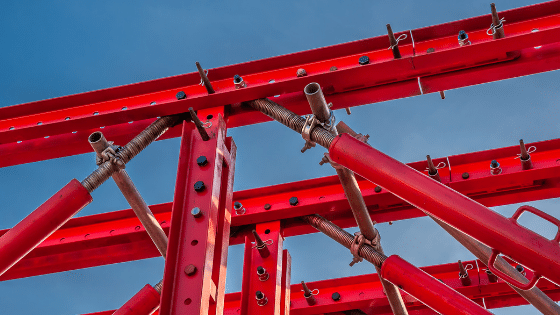
An I-beam—or ibeam—is a standard structural steel shape that serves as critical framework for the metal building industry for a range of constructions. For instance, I-beams go into building bridges, parking garages, skyscrapers, hospitals and much more. But what is it about ibeam design that makes them such a quality building material?
Kloeckner Metals is a full-line ibeam supplier and service center. Download our structural plate spec sheet and see what ibeams Kloeckner Metals stocks.
All structural beams have a basic design that include flanges (sometimes called legs) and a web (the long vertical section). The angle connecting the web to the flanges is called the fillet.
The flat flanges at the top and bottom of the beam prevent bending and the web resists blunt force. These components are designed to withstand a maximum bending load with the least material possible and make up the basis of support for high bearing loads.
All beams have a depth, length, and thickness. The depth of the beam is the distance from the top to the bottom. Width is the length of the horizontal flanges. Thickness refers to both the web and flanges.
There are slight differences between I-beams and beams that appear to have all the same characteristics, including H-piles, Universal beams (UB), W-beams, and wide flange beams. While they all have an I-shaped cross section, and the term “universal” hints at its widespread usefulness, there are some slight differences worth noting.
While I-beams are a standard structural steel shape, they are also available as an aluminum beam. The most common all-purpose aluminum metal grade for beams is 6061 aluminum beam. Beams are also made in stainless steel.
Beam supports are add-on components that make for a safer and more versatile building material. For example, they can allow beams to connect with other beams, join beams with other structural steel products, center loads by equally distributing weight, add hoists and other overhead equipment, or attach wires to hang lighting fixtures and other lightweight materials.
They can attach to the beam via various mechanisms, like clamps, screws, threading, and press fits. Beam supports can also attach at various locations along the beam, either as a bottom mount, top mount, or bottom-center mount.
I-beam clamps are among the most popular beam supports.
Calculations of ibeams predict bending and stress tolerances. Beam depth, which is also the beam height, and the width are the main determinants.
Another common calculation of ibeams is the workable gage. The workable gage denotes the distance permitted for bolts and washers to work or fit with clearance from the edges. It’s the space required between bolts. For example, workable gage would be a necessary consideration when connecting a beam with a bolt to a common flange.
Like other structural steel shapes, including structural channels, structural tubes, structural angles, and structural steel plate, structural steel beams are available in different grades. Depending on the type of engineering or construction project at hand, some of the standard grades used for I-beams include: ASTM A992, ASTM A709-50, and ASTM A572-50.
You can also check out our blog post on the full rundown of structural steel shapes to learn more about other structural steel product types, common applications, and the differences between the S-beam, W/I-beams, T-beams, and bearing piles. Kloeckner Metals stocks and can customize these structural shapes to customer specification.
Kloeckner Metals is a full-line steel supplier and service center. Kloeckner Metals combines a national footprint with fabrication and processing technologies and most innovative customer service solutions.

Steel base plates are fundamental elements employed in various manufacturing...
Metal fabrication is a critical process that transforms raw metal...
The solar industry has undergone a significant transformation by incorporating...

X
The Kloeckner Metals website uses modern technologies. Unfortunately, your browser doesn't support those technologies.
Download the latest version of one of these browsers to experience the site: